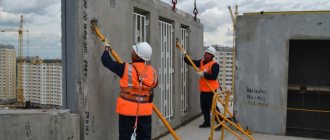This is how business in Russia works, that in order to properly maintain records and calculate taxes, an accountant constantly has to take on unusual functions and master “related” professions. But if accountants are accustomed to being “a little bit of a lawyer” and “a little bit of a personnel specialist,” then the need to become “a little bit of a builder” turns out to be unexpected. And such a need arises, and it is connected with a very common situation - renovation work in the office. After all, their tax accounting depends on the correct classification of the work performed. And in some cases - the very opportunity to take such expenses into account when taxing. In addition, sometimes correctly qualifying a job is also important for civil law relations. Let's look at these situations in more detail.
Repairs in rented premises
According to the general rule, stated in Article 616 of the Civil Code, when renting property, responsibilities for its repair are distributed as follows: current repairs are the responsibility of the tenant, and major repairs remain with the lessor. Usually, when leasing office real estate, these rules remain unchanged, since the lease terms are most often short, and it is inappropriate to shift major repairs to the tenant (and the Civil Code of the Russian Federation allows this).
In such a situation, the accountant of the organization renting the premises, when carrying out repairs, needs to clearly understand what kind of work relates to the current repair. After all, if an organization “accidentally” carries out major repairs, there may be problems with taking into account expenses for tax purposes, since the tenant had no obligation to carry out such repairs. Consequently, the expenses may be considered unjustified (Article 252 of the Tax Code of the Russian Federation).
The situation is similar for the landlord. Here it is important to understand which of the tenant’s requirements for repairs must be met, because these requirements relate to major repairs, and which requirements are not justified. Accordingly, for the landlord, the tax accounting of repair costs will depend on the correct answer to this question.
Where to start overhauling electrical equipment in an apartment building
This approach is justified by the norms of Section VIII of the Housing Code “Management of Apartment Buildings”: the person managing an apartment building is responsible to the owners of the premises in the apartment building for the provision of all services and (or) performance of work that ensure the proper maintenance of the common property in this building. Since major repairs are an integral part of the proper maintenance of common property in an apartment building, the organization managing the building is responsible for its implementation. Such an organization is a “performer of major repairs”, responsible to the owners of premises in an apartment building for its implementation, and the owners of the premises pay it for the repairs carried out. The organization that manages the house independently decides on the issues of attracting contractors, concluding contracts with them and monitoring their work. Secondly, when forming a capital repair fund in a special account, the owners have the right to independently determine the amount of money that can be spent on major repairs. Unlike the regional operator, property owners are not limited by the maximum cost of work and (or) services for major repairs of common property in apartment buildings, approved by a resolution of the Moscow Government. If there are insufficient funds in a special account, the owners of the premises have the right to establish additional contributions and attract credits (loans) from any organizations and individuals to finance capital repairs, if they make an appropriate decision at the general meeting.
Within 10 working days, in the section where you asked the question, a link to the section to which your question was moved will be posted.3. To start a discussion of a problem that interests you, join an existing discussion, or start a discussion on questions that have not received a proper answer in the “Questions and Answers” section, go to the required forum in the “Discussion” category and create a new topic, or select an existing one.4. Before asking a question, use the search, probably a similar question has already been asked and there is an answer.5.
We recommend reading: Payments for Oshm to the Military in 2020
Repair or modernization
Another point when an accountant has to operate in construction terms is related to the peculiarities of accounting for modernization (completion, retrofitting, reconstruction). Indeed, in contrast to repairs, the costs of which are taken into account at a time (Article 260 of the Tax Code of the Russian Federation), expenses for such activities are written off through depreciation (clause 2 of Article 257 of the Tax Code of the Russian Federation).
At the same time, the legislator made an attempt to remove possible questions and gave definitions of completion, reconstruction and modernization in the Tax Code (see box).
Definitions from the Tax Code of the Russian Federation
According to Article 257 of the Tax Code of the Russian Federation: Work on completion, additional equipment, and modernization includes work caused by a change in the technological or service purpose of equipment, a building, structure or other object of depreciable fixed assets, increased loads and (or) other new qualities. For the purposes of this chapter, reconstruction includes the reconstruction of existing fixed assets associated with the improvement of production and the increase of its technical and economic indicators and carried out under the project for the reconstruction of fixed assets in order to increase production capacity, improve quality and change the range of products. Technical re-equipment includes a set of measures to improve the technical and economic indicators of fixed assets or their individual parts based on the introduction of advanced equipment and technology, mechanization and automation of production, modernization and replacement of obsolete and physically worn-out equipment with new, more productive ones.
But, it should be admitted with regret that these definitions turned out to be of a rather general nature; Based on them, it is often difficult to attribute specific work to modernization. Considering the cost of repair (modernization) work, the cost of an error here is quite high. And in both directions: if the modernization is incorrectly classified as a repair, the organization will face additional charges, penalties and fines. And in the opposite situation - losses due to overpaid income tax.
So in this case, it would be a good idea for the accountant to refer to the repair criteria and once again make sure that the work performed is (or is not) a modernization.
Documents and definitions
So where can an accountant get information about which specific construction works are considered current repairs, which are major repairs, and which are considered modernization? The list of relevant sources is given in the letter of the Ministry of Finance of Russia dated November 23, 2006 No. 03-03-04/1/794. When resolving the issue of classifying work as construction, the financial department recommends relying on the following documents:
- Regulations on carrying out scheduled preventative repairs of industrial buildings and structures MDS 13-14.2000, approved by Decree of the USSR State Construction Committee dated December 29, 1973 No. 279;
- Departmental Construction Standards (VSN) No. 58-88 (R) “Regulations on the organization and implementation of reconstruction, repair and maintenance of buildings, municipal and socio-cultural facilities” (approved by Order of the State Committee for Architecture under the USSR State Construction Committee dated November 23, 1988 No. 312) ;
- Letter of the USSR Ministry of Finance dated May 29, 1984 No. 80 “On the definition of the concepts of new construction, expansion, reconstruction and technical re-equipment of existing enterprises.”
On our own behalf, we would add that the general document on this topic is the Town Planning Code, and in controversial situations you can seek advice from the relevant ministry - the Ministry of Construction of Russia. Specialists from this department, just like specialists from the Ministry of Finance, are required to respond in writing to requests from organizations.
Cheat sheets
It is clear that studying all the above documents requires a huge amount of time. Therefore, we have prepared special cheat sheets, using which you can quickly understand what kind of work has been done in your case. There are three such cheat sheets. One cheat sheet contains lists of works with their breakdown by type. The other is based on definitions given in various regulations. It contains general concepts that make it possible to understand the type of work “at the top level.” The third cheat sheet, dedicated to modernization, stands apart in this series. It contains signs of modernization and explanations for them.
When working with our cheat sheets, we suggest using the following algorithm.
First, based on the “modernization” cheat sheet, we decide whether our work relates to repair or whether it is a modernization.
Then, having made sure that we are talking about repairs, we must try to find the types of work being performed in the first table and, based on this, determine which repairs - current or major - they relate to.
If the necessary work is not in the first cheat sheet, then we turn to the second and try to apply the deductive method, extending the general definition to our private work.
"Modernization" cheat sheet
The main and fundamental difference between modernization, addition, reconstruction and repair is that it changes the operational performance of the building. For example, the capacity of engineering communications increases, corridors are expanded, and the like. That is, the building receives new properties, and its characteristics are qualitatively improved.
But it must be taken into account that the operational performance of a building may change during major (and even sometimes during current!) repairs. Therefore, it is important to take into account two more indicators: the scale of change and the goal. Thus, during repairs, improved performance is always a side effect associated with the use of modern materials and (or) technologies. This effect is not the purpose of the work being carried out and is optional. And in scale, such improvements are not comparable with the scale of all the work being carried out; in the estimate and schedule they do not occupy a leading role.
During reconstruction and modernization, on the contrary, improving performance is the main goal of the work carried out. They determine not only the choice of materials and technologies for carrying out work, but also the very need for this work. Accordingly, if the estimate and schedule for reconstruction and modernization contain some work related to repairs, then they are only secondary, caused by the need and type of modernization.
Thus, modernization (reconstruction, addition) can be distinguished from repair by the documents that are drawn up in connection with the work: technical specifications, justification, estimates, schedules, contracts. During modernization, the red thread in all these documents will be quality indicators. And during repairs - quantitative.
This video is unavailable
It turns out that the entire package of documents testified to the alleged major repairs of the apartment building No. 154 on the embankment. can. Griboyedov in St. Petersburg and, according to the Administration of St. Petersburg, was destroyed many years ago, was in the prosecutor's office of St. Petersburg and was provided to Alexander for review on February 25, 2014, on the third day of familiarization with the materials of supervisory proceedings 7-3177-2011 on appeals addressed to the prosecutor of St. Petersburg Litvinenko Sergei Ivanovich.
One of the main problems that Alexander Skurkis brings to the attention of the authorities and the public is the situation related not only to the large-scale falsification by current officials of the Administration of St. Petersburg of the election of management companies in the Admiralteysky district of the city, but also to the conduct by them, officials and commercial structures affiliated with them in the housing and communal services sector, supposedly “major repairs” of apartment buildings. This topic is now relevant for the entire population of Russia, because in the coming years the cost of “major repairs” is going to be imposed on homeowners.
This is interesting: What does it mean when the bailiffs go to your apartment?
Cheat sheet by type of work
Maintenance*
Major renovation**
sealing and filling joints, seams, cracks
resumption of plastering of all premises
restoration in some places of the lining of the foundation walls from the basements and plinths
replacement of existing and installation of new technological equipment in buildings
re-laying of individual sections of brick walls up to 2 sq.m.
renovation of built-in premises in buildings
elimination of local deformations by re-lining and strengthening walls
insulation and noise protection of buildings
insulation of freezing sections of walls in individual rooms
repair of plaster in the amount of more than 10% of the total plastered surface
restoration of individual walls, lintels, cornices
production of design and estimate documentation
partial replacement or strengthening of individual elements of wooden floors
changing the roof structure
strengthening the elements of the wooden rafter system, including changing individual rafter legs, racks, struts, sections of purlins, sheathing.
equipment of attic spaces for use
elimination of dampness, airflow
transfer of the existing power supply network to increased voltage
cleaning ventilation ducts and exhaust devices
installation of automatic fire protection and smoke removal systems
repair of ventilation ducts and exhaust devices
partial re-laying (up to 10%), as well as strengthening of stone foundations and basement walls, not associated with the superstructure of the building or additional loads from newly installed equipment
antiseptic protection of wooden structures
repair of existing drains around the building
fire protection of wooden structures
sealing cracks in brick or stone walls, clearing furrows, and bandaging seams with old masonry
strengthening and replacing drainpipes
repair, replacement and replacement of worn partitions with more advanced designs of all types of partitions
strengthening and replacement of small coverings of architectural elements along the facade
partial or complete replacement of rafters
cleaning the roof from snow and ice
partial (over 10% of the total roof area) or complete replacement or replacement of all types of roofing
replacement, restoration of individual elements, partial replacement of window, door stained glass or showcase fillings (wooden, metal, etc.)
partial (more than 10% of the total floor area in the building) or complete replacement of all types of floors and their bases
replacement of individual sections of pipelines, shut-off and control valves
repair or replacement of interfloor ceilings
changing sections of heating devices, shut-off and control valves
replacement and strengthening of all types of stairs and their individual elements
replacement of individual sections of flooring.
continuous anti-corrosion painting of metal structures
restoration of destroyed sections of sidewalks, driveways, paths and platforms
repair and renewal of cladding with an area of more than 10% of the cladding surface
punching (sealing) holes, sockets, grooves.
continuous painting with stable compounds.
replacement of individual sections of blind areas around the perimeter of buildings
partial or complete replacement of air ducts
restoration of the building layout.
change of fans, heaters, filters
replacement of individual appliances (cisterns, toilets, washbasins, sinks, urinals, drinking fountains, water taps)
partial or complete replacement of ventilation ducts
change of individual sections of electrical wiring (up to 10%).
replacement of worn-out sections of the electrical network (more than 10%)
all types of plastering and painting works in all premises
Definitions cheat sheet
Type of repair/regulatory regulations
VSN
Regulation 279
Town Planning Code
Capital
Restoring the life of a building, replacing, if necessary, structural elements and engineering equipment systems, as well as improving operational performance
Replacing worn-out structures and parts of buildings and structures or replacing them with stronger and more economical ones that improve the operational capabilities of the objects being repaired, with the exception of the complete replacement or replacement of the main structures, the service life of which is the longest (stone and concrete foundations, all types of walls and their frames, pipes of underground networks, bridge supports, etc.) – clause 3.11
Replacement and (or) restoration of building structures of capital construction projects or their elements (with the exception of load-bearing structures), systems and networks of engineering support, as well as replacement of individual elements of load-bearing building structures with similar or other indicators that improve them and (or) restoration of the specified elements (clause 14.2 art. 1)
Current
Restoring the serviceability (operability) of structures and systems of engineering equipment of a building, as well as maintaining its operational performance
Systematic and timely protection of parts of buildings and structures and engineering equipment from premature wear by carrying out preventive measures and eliminating minor damage and malfunctions - clause 3.4
Ensuring the proper technical condition of buildings and structures. In particular, maintaining parameters of stability, reliability of buildings, structures, serviceability of building structures, systems and networks of engineering support, their elements in accordance with the requirements of technical regulations, design documentation (Part 8 of Article 55.24)
Questions and answers on the topic
Is a project required to overhaul the power supply of the microdistrict?
Yes, therefore, even without delving into the regulations, you can say that the project will be required. The issue of approving the project with Rostechnadzor most likely will not arise (most likely), but the issue of examination (state examination) of the project is a very pressing issue, and we need to focus on this.
This is interesting: Electronic queue of military personnel to receive a housing subsidy from the Russian Ministry of Defense
According to urban planning, design documentation is required. At least to the extent that drawings and diagrams are needed. At least in the form of a working draft. And moreover, commissioning is needed as a separate section of the estimate documentation. And commissioning is confirmed by a measurement protocol from a licensed laboratory. This is ideal. If it’s reconstruction, then there’s also an examination of the design documentation .
Answer
The costs of repairing low voltage cable networks of 0.4 kV (by replacing the cable by laying it in the ground) should be reflected under expense type element 243.
As a rule, current repairs mean the maintenance of fixed assets to maintain them in working condition (clause 8 of Article 55.24 of the Civil Code). Major repairs involve the replacement or restoration of basic elements - parts, structures, etc. (clauses 14.2, 14.3 of Article 1 of the Civil Code). The institution independently determines which repairs are current and which are capital. It should be noted that issues of classifying work as major or current repairs do not fall within the competence of the accounting (financial) service of a state (municipal) institution and can finally be resolved only by the relevant technical specialists. The basis for determining the types of restoration work should be the relevant documents developed by the technical services of organizations within the framework of the system of scheduled preventive maintenance. This was stated in the letter of the Ministry of Finance of Russia dated January 14, 2004 No. 16-00-14/10.
In accordance with Appendix 8 “Regulations on carrying out planned preventative repairs of industrial buildings and structures” dated December 29, 1973 No. 13-14.2000, 279, repair of low voltage cable networks 0.4 kV (by replacing the cable by laying it in the ground) is more correctly classified as for a major overhaul. Therefore, reflect expenses by element of expense type 243.
Overhaul of electrical supply in apartment buildings
Major repairs within the framework of 185-FZ 2008-2011. Ryazan 1. HOA “Trollebus” - st. Zubkovoy 24k1 2. HOA “On Teatralnaya” - st. Firsova, 2 3. HOA “Fakel” - st. Krupskaya, 4 4. Homeowners' association "Kometa" - Dzerzhinskogo st., 64 5. Housing cooperative "Stanochnik" - Oktyabrskaya st., 58 6. Homeowners' association "Oka" - st. Rechnikov passage, 5/9 7. Housing complex “Refiner” - st., Sovetskaya Armii, no. 26k1 8. Housing cooperative "Im. Kashirina" - st. Velikanova, 10k1 9. HOA “Kommunalnik” - st. Lomonosova, 3 10. TD “Moskovsky” - st. Biryuzova, 29 11. Housing cooperative “Health 1” - st. Velikonova, 8 12. Housing cooperative “Health 2” - st. Krupskoy, 3k1 13. Housing complex “Neftyanik” - st. Gogolya, 59/3 14. HOA “Avtomobilist” - Gagarin St., 48 15. HOA “Soldier” – Novoselov St., 32k3 16. HOA “Fiber” – Novoselov St., 32 17. Housing cooperative “Teacher” -3” — st. Timurovtsev, 11 18. Homeowners' Association "Dynamo" - Dzherzhinskogo St., 24k1 19. Homeowners' Association "Pobeda 66" - Pervomaisky Avenue, 66 20. Homeowners' Association "Gidrometalurg" - 1st Prudnaya St., 22 21. Housing cooperative "named after Poletaev" - st. Velikanova, no. 2 22. Housing cooperative "named after Pirogov" - Yubileynaya st., no. 12 23. Housing cooperative "Chapaev" - st. Zubkovoy, 4 24. HOA “Meditsinsky” - st. Zubkovoy 22k2 25. HOA “Zhilstroy” - st. Ostrovsky, 23k2 26. Housing complex “Udarnik” - st. Gogol, no. 56 27. HOA “Domostroitel-3” - Novoselov, no. 31 28. HOA “U Fontana” - Zubkovoy, no. 27 29. LLC “Zhilbytservis” - st. Soviet Army no. 3k4 30. LLC “ZhEU-10” - st. Bronnaya, 19 31. LLC “ZhEU-10” - st. Bronnaya, 20 32. Housing cooperative “Avtotransportnik” - st. Timurovtsev, 5k1 33. Housing complex “Horizon-2” - Yesenina st., 38 34. HOA “Leader” - Selskikh Stroiteley str., 5B 35. Housing cooperative "Zarya-1" - st. Engelsa, 14 36. Housing cooperative “Soyuz” - st. Velikonova, 11k2 37. Housing complex “Zapolyarnik” - st. Velikonova, 8k1 38. Housing cooperative “Otdykh” - st. Krupsoky 5k2 39. Housing complex “Mercury” - st. Rybatskaya, 6 40. HOA “Crystal” - st. Zubkovoy 5k1 41. HOA “Michurin” - st. Stankozavodskaya, 21k1 42. Homeowners Association “Cosmos” - st. Stankozavodskaya, 15 43. Housing cooperative “Shveinik” - st. Timakova, 13 44. Housing cooperative “Avtotransportnik-1” - st. Novselov, 35k4 45. Housing complex “Rodnik” - st. Novosvelov, 35k3 46. HOA “Holodilshchik” - st. Novoselov, no. 33k2 47. LLC UO “Kombainbytservis” - Belyakova St., no. 8 48. HOA “Ivanovskoye” - village Ivanovskoye, no. 1 49. HOA “Holodilshchik-2” - Novoselov str., no. 50 50. HOA “ Kolos-2” - st. Shchersa, no. 5 51. LLC “Primier-comfort” - Shchersa st., no. 35k1 52. HOA “Karla Makrksa 12” - Karl Marx str., no. 12 53. LLC “ZhKO Sokolovka” - st. Svyazi no. 17 54. LLC “ZhKO Slakovy” - st. Kachevskogo 4k5 55. LLC “ZhKO Slakovy” - st. Mashinostroiteley 6k1 56. LLC “ZhEU-10” - st. Bronnaya, 21a 57. LLC “ZhEU-10” - st. Cultures, no. 4 58. Housing complex “Vostok” - st. High-voltage house 29 59. LLC “ZhEU-21” - st. Lermontova, 18 60. HOA “Nightingale” - st. Poleva, 4 61. LLC “Firma Fakt-N” - st. Pervomaisky prospect, 66k2
Our company has specialized in carrying out major repairs of electrical supply systems in residential buildings since 2003. During this time, our specialists have accumulated considerable experience in solving a whole range of problems in this area, starting with the development of design documentation for various types of houses, ending with successful commissioning after a major overhaul.
Replacement of electrical wiring current repair or major
Current electrical wiring repairs
residential buildings includes partial replacement of internal electrical wiring of lighting and power electrical installations; re-tightening of sagging electrical wiring in staircases, cages, attics and underground areas; checking the grounding of cable sheaths, shields and shields; re-tensioning of overhead line wires with adjustment of the sag, as well as stretching loose bands and changing attachments for composite single-post supports; re-cutting and termination of cable ends; cleaning the contact surfaces of devices from oxides, lubrication and regulation of their mechanisms, changing the coils of electromagnets.
The housing stock of most cities and urban-type settlements is very heterogeneous in terms of technical condition. According to the accepted schemes, complexity, installation method and material of the electrical wiring of most residential and public buildings, the wiring differs significantly. In many residential buildings, due to the increased use of household electrical appliances, the wire cross-section does not correspond to the actual load. Overloading of electrical wires in residential buildings is one of the most significant reasons for the deterioration of wire insulation and leads to the need to repair electrical wires.
Current and major repairs - what's the difference?
It is worth noting the cosmetic renovation. It is mentioned in the article. As a rule, these are light, non-essential jobs. This is a certain restoration of premises with the aim of externally improving its aesthetic condition. Cosmetic repairs include painting walls, ceilings, floors, doors, baseboards, laying laminate or other floor coverings, etc.
- replacement of certain parts or certain devices due to wear;
- replacement of technical equipment;
- carrying out a number of specific works to improve the level of improvement of the premises inside (modernization);
- repair of window sills, baseboards, slopes;
- selection of a design project;
- installation of plumbing, pipes;
- wall preparation, painting;
- laying parquet, laminate, tiles;
- installation of ceilings, etc.
Replacement of electrical wiring in an apartment building 2020
Removing furniture with partial discarding, removing old flooring and, possibly, the floor itself, tearing off old wallpaper, dismantling old plumbing, interior doors... And this is just the beginning. Next on the schedule is the replacement of heating risers, hot water supply, hot water supply and sewerage, work on leveling walls, floors and ceilings, replacement of doors and windows, installation of new coatings for the same walls, floors and ceilings.
We recommend reading: Tips for passing the city traffic police exam
In the case of laying cables in grooves, you can not use any pipes, but install the lines “as is” using plastic dowel clamps. In this case, however, the formal requirement for the replacement of wiring will be violated, but this requirement can actually be neglected in favor of labor productivity and lower cost of work.
Replacing electrical wiring in an apartment during a major renovation
And, in general, it must be admitted that for the level of electricity consumption of that time, all this was more than enough. After all, not even an electric kettle was available in every apartment back then. And the power of the latter, even if it was present, was incomparable with the power of modern fast-boiling examples.
Of course, changing the grounding system in a single apartment is an almost impossible task. In our apartment network, we can only lay an additional third wire, without connecting it in the apartment panel until the general building engineering networks are brought into compliance with the current requirements of regulatory documents. But this will still have to be done someday. And a major overhaul is the most appropriate moment for this.
Overhaul of electrical supply in apartment buildings
But in this case, there is no way to do without a major overhaul of the power supply system. It must be carried out taking into account the requirements of the Energy Saving Law No. 261-FZ. Replacing cables, installing motion sensors and energy-saving lamps will help significantly reduce energy consumption both in common areas and in apartments. And installing modern meters will help prevent illegal connection to public networks.
A residential building that lacks engineering systems is nothing more than an ordinary empty concrete box, which is in no way intended for normal human life. This is understandable, because a person simply needs heat, water supply, a sewerage system, electricity, ventilation and much more that makes life comfortable in principle.
Replacing window units is a current or major repair
The task of current repairs is to renew the life of a structure without making major changes to its design; utility networks are also not subject to modifications. Current repairs do not require the creation of a separate project; they are more economical than reconstruction and overhauls, and are carried out in a shorter period of time.
The first of the listed points defines the term “Housing Maintenance Organization”. The resolution states that this includes maintaining the fully functional condition of windows, door structures, lighting fixtures, maintaining the sound and heat insulation characteristics of windows in accordance with standards, and periodically cleaning glass.
Current, planned and major repairs of electrical equipment
- 1. Check for the presence of lubricating oil in the bearings.
- 2. Measuring the insulation resistance of the windings with a megohmmeter.
- 3. Restoration of insulation at jumpers and output ends.
- 4. Check:
- — serviceability of grounding;
- — belt tension;
- — correct selection of fuse links.
The timing and dates of planned repairs of electrical equipment are coordinated with several structural divisions of the organization: the instrumentation and automation service, repairmen, departments for servicing related equipment, departments that use this equipment according to their schedule, and power engineers.
Current and major repairs of wiring in the house
Repairing wiring in a house is usually carried out during a major renovation of the building. However, major wiring repairs may be required when installing some types of household appliances, for example, when installing an air conditioner. In this case, repairing the wiring may require replacing the type of cable and increasing the number of cores. Routine wiring repairs include activities to maintain all elements to ensure the functionality of the entire system. The repair of wiring equipment may include replacing some sections and checking the RCD.
All equipment installed in the house sooner or later has to be replaced during general repairs or due to the fact that some part has failed. That is why issues such as troubleshooting electrical wiring, repairing lighting wiring in the ceiling, repairing and replacing sockets, switches, wires, etc. will always be relevant. Do not forget that to perform any repair work you need to use specialized tools, the handles of which are equipped with an insulating coating.
Electrical supply of multi-apartment residential buildings
And finally, the third category of power supply is the simplest. In it, a residential building is powered from a transformer using a single cable. There is simply no backup option. Because of this, during accidents, the interruption in the supply of electricity to the house sometimes lasts up to 24 hours. Therefore, it is always advisable to have a backup option for autonomous power supply to your home.
The other extreme also has serious disadvantages - if you make a big mistake when choosing materials, and the electrical network has too high a power, then you will have to overpay a lot of money when purchasing the required amount of electrical cable.
GASK requirements for current electrical wiring repairs
In 2020, the inspection authorities drew attention to the fact that when announcing a competition for current repairs, the organizers establish a requirement for a category III license (last year this was not the case). This requirement appeared after consultation with the State Architectural and Construction Control (GASC).
The license states that the supplier has the right to work on the installation of utility networks and systems, including major repairs and reconstruction of power supply networks, including: 4) power supply networks and external electric lighting, internal electric lighting and electric heating systems.
Frequently asked questions about major renovations of residential buildings
FAQ
What is a capital improvement fund?
Monthly contributions from the owners of premises in an apartment building form a fund for capital repairs of the house - a kind of piggy bank. By decision of the general meeting, it may also receive income received from leasing or other use of common property.
What are the ways to accumulate funds for major repairs?
There are two accumulation options:
1) on the account of the “Capital Repair Fund” - an organization specially created by the Moscow government to accumulate funds from owners and organize capital repairs;
2) in a special bank account opened for a specific house.
Although the first method of accumulation is often called a “common pot”, the owners’ payments are kept in the “Fund” for each apartment. Owners do not need to organize repairs - the “Fund” takes full responsibility for organizing major repairs within the time frame established by the regional program: attracts contractors, controls the quality and timing of work, accepts completed work, bears responsibility for non-fulfillment or improper fulfillment of obligations by contractors organizations. Proceeds to the “Fund” are spent on major repairs of some houses at the expense of others according to the “mutual aid cash fund” principle, in the order of priority established by the regional capital repair program.
When choosing the second savings method, owners can open a special account in a Russian bank from the list published on the website of the Central Bank of the Russian Federation. Owners must choose the owner of the special account. It could be a management company, a homeowners' association, a housing cooperative or a "Capital Repair Fund". The list of transactions with money in a special bank account is strictly regulated. When accumulating funds in a special bank account, the owners independently select a contractor for major repairs and enter into an agreement with him. Major repairs with this method of accumulation are carried out either within the time frame established by the regional program, or, if necessary, ahead of schedule if there are sufficient funds in the account or with the use of a loan.
Important! Regardless of the accumulation method, major repairs must be completed no later than the deadlines established in the regional program.
Please pay attention! The owners choose the method of accumulating funds for major repairs independently at a general meeting. The decision is considered adopted if at least 2/3 of the total votes are cast for it (part 1 of article 46, clause 1, 1.1 of part 2 of article 44 of the RF LC).
What is the deadline for making decisions on choosing a method of saving for major repairs?
Owners must make their choice and have time to implement the chosen method before June 1, 2020 (clause 4.1 of Moscow Government Decree No. 833-PP dated December 29, 2014 “On establishing the minimum amount of contribution for major repairs of common property in apartment buildings in the city of Moscow”) .
Note! If the owners do not independently choose the accumulation method before June 1, 2020, then their contributions will go to the “Capital Repair Fund” account!
How much do you have to pay?
The amount of contributions for major repairs is determined for each region individually. In Moscow, the minimum contribution for major repairs is 15 rubles. from 1 sq. m of total area per month (clause 2 of Moscow Government Decree No. 833-PP dated December 29, 2014 “On establishing the minimum amount of contribution for major repairs of common property in apartment buildings in the city of Moscow”).
The fee is paid by the owners of both residential and non-residential premises. Tenants are not charged for major repairs.
Are benefits and subsidies still in place?
Yes, they are saved! The introduction of fees for major repairs will not affect the situation of low-income and privileged categories of citizens. Since the contribution for major repairs is included in the payment for residential premises, it is subject to existing benefits (for preferential categories) and subsidies (for low-income citizens).
What types of work can be performed in the house using accumulated funds?
The mandatory list of works (services) for major repairs, taking into account the characteristics of a particular house, includes (Moscow Government Decree No. 833-PP dated December 29, 2014):
1) repair of in-house engineering power supply systems;
2) repair of in-house engineering heat supply systems;
3) repair of in-house gas supply systems;
4) repair of in-house engineering water supply systems (hot and cold water supply);
5) repair of in-house engineering drainage systems (sewerage);
6) repair or replacement of elevator equipment recognized as unsuitable for operation, repair of elevator shafts;
7) roof repair;
 repair of basements belonging to common property in an apartment building;
repair of basements belonging to common property in an apartment building;
9) facade repair;
10) foundation repair;
11) repair of the in-house smoke removal system and fire automatics, repair of the fire water supply system;
12) repair or replacement of the garbage chute;
13) repair or replacement of internal drainage;
14) development and examination of design documentation, implementation of construction control, assessment of compliance of elevators with the requirements of the technical regulations of the Customs Union “Safety of Elevators”.
Where can I view the regional capital improvement program?
The regional capital repair program was approved by Moscow Government Decree No. 832-PP dated December 29, 2014 “On the regional capital repair program for common property in apartment buildings in the city of Moscow.” The program is available for review on the website of the Moscow Department of Capital Repairs.
Current repairs to replace electrical wiring with all electrical appliances in
Current repairs to replace electrical wiring with all electrical appliances in the food service area in the Yakorek building. Installation of an exhaust system above the washing baths in the Yakorek building. Current repairs of ventilation in the catering unit in the Rucheyok building. Major repairs to replace window and door units in all buildings. Purchase of refrigeration equipment (refrigeration cabinet - 1 piece, chest freezer - 2 pieces) for the Yakorek building. Major renovation of the bathroom and food service area in the Yakorek building. Total. Types of jobs. Funds raised by MADO. Budget of the Perm Territory (subsidies). Total. 48000. 192000. 7440. 22320. 29760. 968610. 2905830. 3874440. 15786. 47358. 63144. 82080. 246240. 328320. 1234916. 3652657. 4867573. 144000. 113000. 266909. 379909.
“Sexually transmitted infections” - Take care of each other. “Classic” venereal diseases. Herpetic infection. What symptoms indicate an STI? Sexually transmitted infections. Gonorrhea. Irreversible changes in the genital organs. HIV. Symptoms of genital herpes. Syphilis. Inflammation of the testicle and prostate gland.
Replacement of electrical wiring current repair or major
2. You can make all the wiring in the apartment just for you. Each socket, lamp, switch and even the apartment panel will be located exactly where it will be convenient and safe for you. The number of sockets and lamps will also correspond to your needs; no tees or extension cords will be needed.
The most effective, but also the dustiest method of gating is using a grinder with a diamond blade. We punch holes for installing sockets and junction boxes using a hammer drill with a concrete bit. There is nothing to do here with the impact drills that are familiar to many. You should not forget about protective equipment: the grinder needs a casing, and the worker needs a respirator to protect the respiratory system. Safety glasses will also come in handy.
>>>
Forum for electricians, installers, power engineers, designers
The house is planning a major overhaul of the electrical system. The project provides for the replacement of ASU, replacement of floor panels, replacement of automatic switches, replacement of inputs into apartments up to the apartment control panel. Nothing changes in the apartment itself, i.e. the two-wire system remains. And the question arose: is it necessary to switch from TN-C to TN-CS with the division of the PEN conductor into PE and N in the ASU or should the TN-C system remain. Thank you in advance.
The house is planning a major overhaul of the electrical system. The project provides for the replacement of ASU, replacement of floor panels, replacement of automatic switches, replacement of inputs into apartments up to the apartment control panel. Nothing changes in the apartment itself, i.e. the two-wire system remains. And the question arose: is it necessary to switch from TN-C to TN-CS with the division of the PEN conductor into PE and N in the ASU or should the TN-C system remain. Thank you in advance.
This is interesting: Law 138 Federal Law on the allocation







